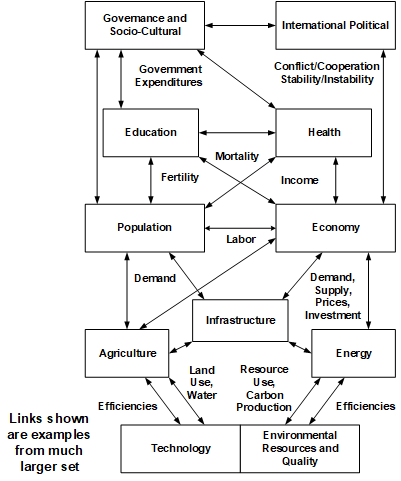Model Documentation - IFs
Jump to navigation
Jump to search
| Corresponding documentation | |
|---|---|
| Previous versions | |
| Model information | |
| Model link | |
| Institution | Frederick S. Pardee Center for International Futures, University of Denver (Pardee Center), Colorado, USA, https://pardee.du.edu/. |
| Solution concept | |
| Solution method | Dynamic recursive with annual time steps through 2100. |
| Anticipation | Myopic |
International Futures (IFs) is a long-term integrated assessment model or system which is a collection of several hard–linked, directly interconnected models (sometimes referred to as modules). It is dynamic recursive with annual time steps to 2100. It represents 186 countries connected through a variety of flows, facilitates aggregation of them to global regions, and allows subdivision of them into more local socio-political units. The IFs system is available for use by others both on-line and in a downloadable version, and it is open source. Major models in IFs (see Figure below) include
- a multistate population model (which represents 22 age sex cohorts to age 100+ and differentiates their educational attainment and cause-specific mortality patterns).
- a multisector general equilibrium economic model (which uses inventories as buffer stocks and to provide price signals so that the model chases equilibrium over time); it provides labor, investment, and consumption information to partial equilibrium energy and agriculture models.
- an education model that tracks grade-by-grade student progression and aging of adults with variable attainment levels.
- a health model that represents age-sex specific mortality and morbidly by 15 causes of death.
- socio-political representations that include governance capacity and finance, wrapping the economic model in a broader social accounting matrix.
- an energy model (which portrays production of six energy types: oil, gas, coal, nuclear, hydroelectric, and other renewable). Physical values from the partial equilibrium model are converted to currency values to replace those in the general equilibrium economic model.
- an agricultural model (which is a partial equilibrium model in which food stocks buffer imbalances between production and consumption and determine price changes); the model represents crop, gazing, forest, developed and other land. As with energy, physical values converted to monetary values override those in the general equilibrium model.
- an infrastructure model that projects paved roads, access to safe water and sanitation, electricity access, and access to various forms of information and communications technology,
- an environmental model, which allows tracking of remaining resources of fossil fuels, area of forested land, water supply-demand, atmospheric carbon dioxide, and changes in temperature and precipitation.
- an implicit technology model, which allows changes in assumptions about rates of technological advance in health, agriculture, energy, and the broader economy.
